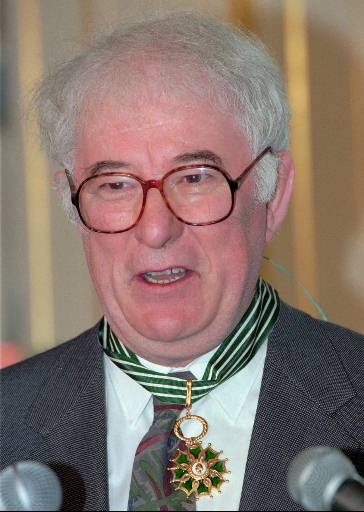‘The past is consumed in the present and the present is living only because it brings forth the future,’ wrote James Joyce in Portrait of the Artist as a Young Man at the turn of the last century.
In truth the words could apply to any writer of note in the past hundred years and, taken in isolation and shorn of its writer, could be dismissed as doggerel.
But in terms of modern Irish literature it is a line which could so easily be given to the work of Nobel-prize-winning Seamus Heaney whose guttural consonants and breeze-like vowels emanate from the bog to the back street. Heaney’s lines have been so drippingly Irish, so steeped in his country’s lore, and historically redolent yet only ever glance sideways to what might come.
Next year, some 45 years after the publication of his first anthology, Death of a Naturalist (1966), Heaney will be turning 72. Born the eldest of eight on a farm near Castledawson, County Londonderry, Heaney started life in rural Northern Ireland and, despite the paths which have led him away from his roots across the decades, has never really left it.
Like many Irish poets of his generation, Heaney had little choice but to reflect the growing civil disobedience of the mid-1960s in Northern Ireland before it erupted into a guerilla war.
Being born a Catholic, one would suspect he might lean towards the nationalist, if not the Republican, cause but there is little evidence to support his beliefs one way or the other. Not that he ignores the issues, he just chooses to see the people behind them.
Perfect for the classroom is Casualty, the narrative of a ‘dole-kept breadwinner’ who (presumably) poached rivers and lakes but in his nightly pursuit of ‘warm lit-up’ drinking haunts was killed ignoring a curfew, days after Bloody Sunday. Heaney mixes fishing analogy with political and historical detail, animating the dangerous and febrile state of things in the wake of Bloody Sunday in 1972, when the Parachute Regiment opened up on demonstrators in Derry.
The waving of black flags and the phoned death threats to those not toeing the line, to which Heaney refers, are details only the Northern Irish of the early 1970s would properly recognise and went unreported at the time.
He was blown to bits
Out drinking in a curfew
Others obeyed, three nights
After they shot dead
The thirteen men in Derry.
PARAS THIRTEEN, the walls said,
BOGSIDE NIL. That Wednesday
Everyone held
His breath and trembled.
(Casualty 1981)
From the earliest collections, Heaney’s view has never been bound to contemporary issues which makes Casualty as neutral a poem as is available from any writer inside the island.
Much of Heaney’s extensive cannon is pastoral and a non-judgemental reflection of the heritage and landscape of Northern Ireland, of its people and culture beyond and before the polarised communities of the latter half of the 20th century.
If Heaney had been an artist the maker of his backdrops might be William Conor, the Belfast painter who spent his career bringing Ulster folk to life in charcoal, pastel and paint. Heaney does the same in words.http://www.inkpellet.co.uk/wp-content/uploads/2010/11/IP77-humanchain.jpg
Between my finger and my thumb
The squat pen rests
I’ll dig with it
(Digging, 1966)
Human Chain is Heaney’s latest book, published by Faber & Faber.




